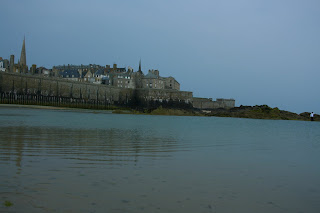Arras was so nice! A charming little town with two charming town squares and lots of interesting limestone quarries. It was a very easy train ride from Paris on Friday and we went out to a restaurant called Le Rapiere that night. This is the second time we have eaten at a restaurant by this name, totally unrelated to one another. We were drawn to each because of their claim to specialize in local cuisine. The first was in Rouen where we had a type of fish stew and Norman holes, which is an unfortunate seeming name for a refreshing apple sorbet. This time, in Arras, we had a savory cheese flan and beef stewed in beer and brown sugar. Delicious.

Over looking the market and Flemish facades.
Saturday we went wandered through a market, got a cold and windy view of the Flemish architecture from a belfry, and then walked across town to the newly opened Wellington Quarry Monument. The town of Arras is situatedatop extensive limestone beds and for about 800 years this limestone was extracted for construction, but by the 19th century the market for limestone dropped off. What remains are the underground tunnels and caverns that were once filled with stone. Some have been used for other purposes since; those directly under Arras’s town square have been used to store goods for markets, as a dumpsite for a china store’s broken dishes, and currently some restaurants offer seating in the tunnels.

In the tunnels directly under the town square.
It was during WWI that the quarries probably had their most significant use. The French troops had left Arras to move further south to defend other positions and British troops came into fill their place. In an attempt to break the stalemate on the Western Front, a plan was designed for the French to launch a major offensive strike. A few days before this attack, it was planned that the Commonwealth troops would launch a distraction in the north near Arras to pull up some of the German troops. The preparation for this diversion took nearly eight months. A group of tunnelers from New Zealand spent most of this time connecting the various limestone quarries that pocket the area until they had a u-shaped tunnel nearly 20km long with its bend in Arras and the two terminuses at the German line. Once everything was prepared the 20,000 troops, who had been slowly gathering at Arras, moved into the cold tunnels and lived there for 8 days until it was time to attack. The day of the attack new exits were blown out and the Commonwealth soldiers came pouring out of the tunnels to the surprise of the Germans. The first three days of fighting were very successful, so successful in fact that the commander decided that his men deserved a day off, which was just enough time for the Germans to call in reinforcements. The Battle of Arras lasted two months with the British gaining 10km of the front, but at the cost of 4,000 lives each day. It is just impossible to picture what that must have been like.

Visitors of the Wellington Quarry Monument can go 20 meters underground and walk through sections of the tunnels that were so key to this battle and where 20,000 soldiers lived for 8 days.
You get to see the latrine set up, the bunks, the kitchen and the communications area.
There are also several carvings and drawings on the limestone walls.
Some of them are humorous – one soldier carefully carved the name of a famous New Zealand cave over the entrance to a tiny storage nook.
Some of them are sad – portraits of girlfriends or wives left behind.
And it was so cold; you can imagine all those men huddled in their wool coats, just trying to pass the time until the call came to fight.
We also took a tour of the Canadian Vimy Ridge Memorial. Like Pont du Hoc, the Canadians opted to leave the land given to them by the French government more or less alone. There are craters from the bombings and trenches, although the original sandbags have been replaced by replicas in concrete. And rather than a traditional cemetery, the Canadian government opted to send over North American trees to be planted there. They sent over 100,000 and they grow around the edges of the battlefield.
Seeing the trenches was pretty cool. It was particularly interesting to visit these because at one point the Canadian and Germans were hunkered down no more than 20 yards from one another. I typically think of wide, smoky no man’s lands strewn with barbed wire, but sometimes they were really right up on top of each other.


 Visitors of the Wellington Quarry Monument can go 20 meters underground and walk through sections of the tunnels that were so key to this battle and where 20,000 soldiers lived for 8 days.
Visitors of the Wellington Quarry Monument can go 20 meters underground and walk through sections of the tunnels that were so key to this battle and where 20,000 soldiers lived for 8 days.
















 be used on the approaching armada. The Rangers arrived to find that the Germans had removed the guns several months earlier in order to build bomb proof shelters for them. In there place were gun sized logs. The Rangers were able to report the mission as a success, but had to wait there for two days before receiving backup due to the fighting conditions on the beach.
be used on the approaching armada. The Rangers arrived to find that the Germans had removed the guns several months earlier in order to build bomb proof shelters for them. In there place were gun sized logs. The Rangers were able to report the mission as a success, but had to wait there for two days before receiving backup due to the fighting conditions on the beach.







